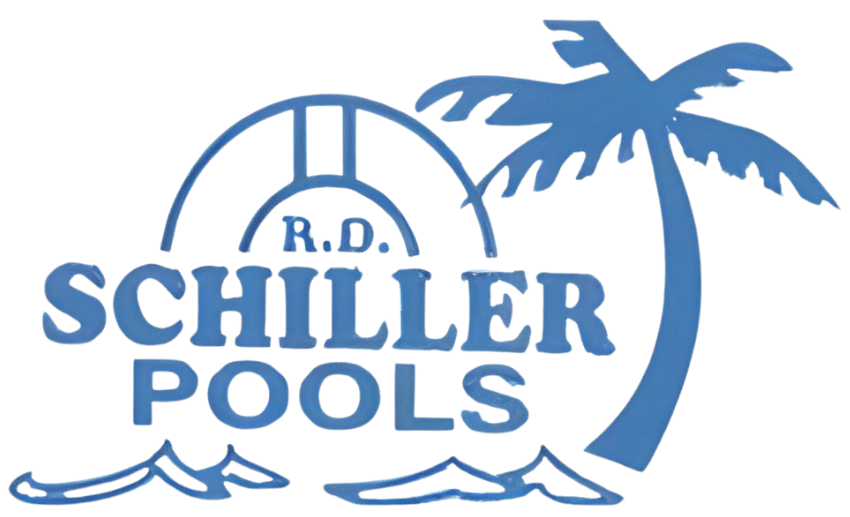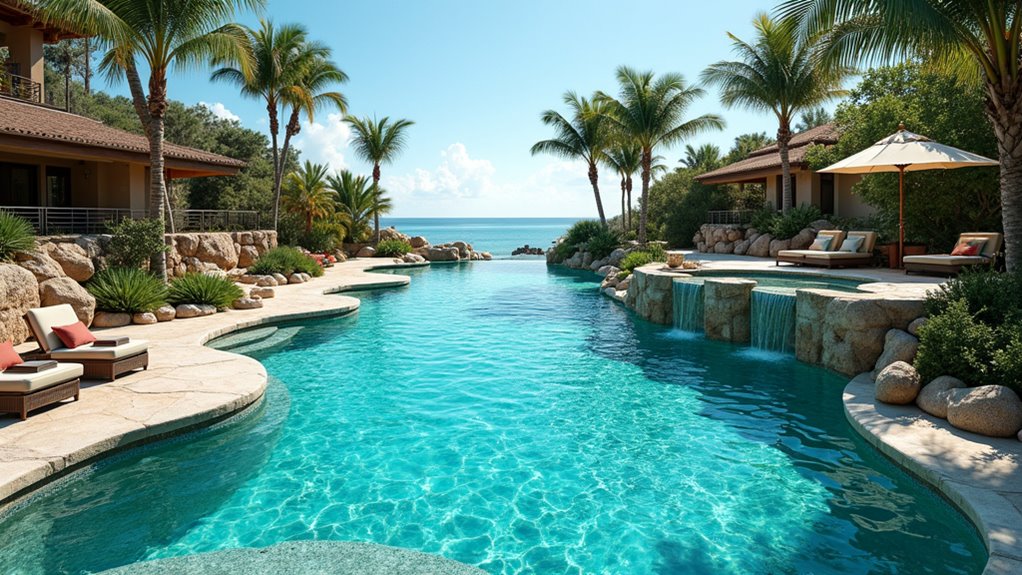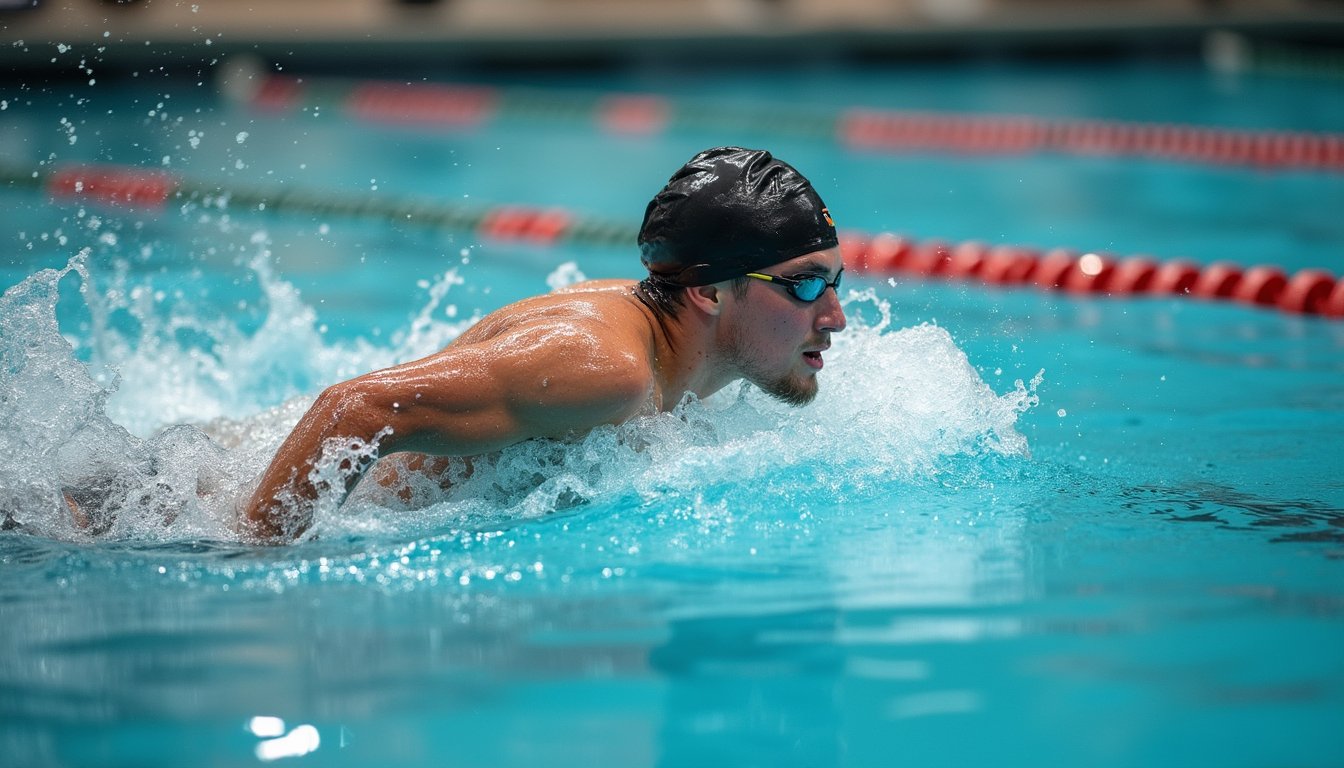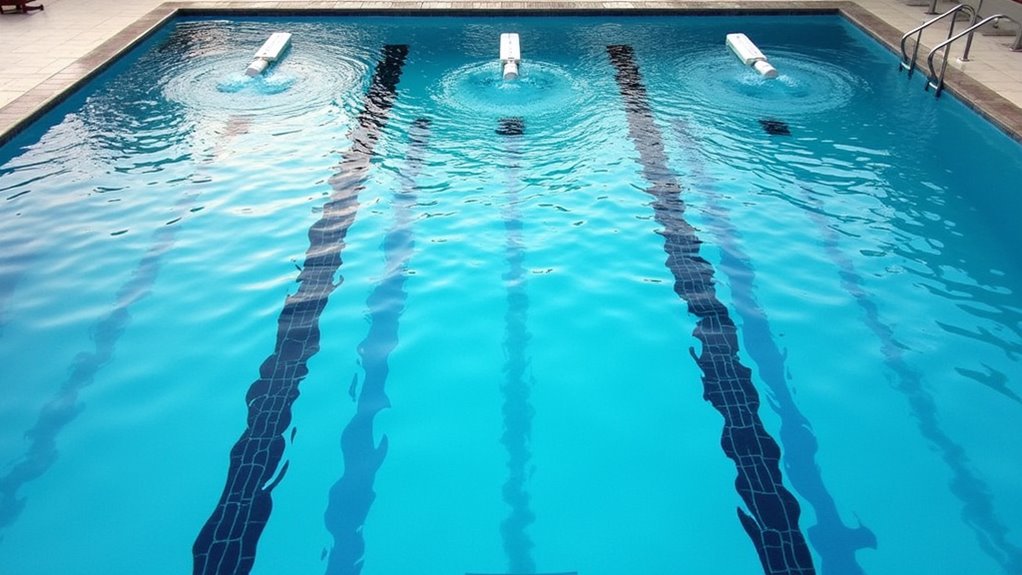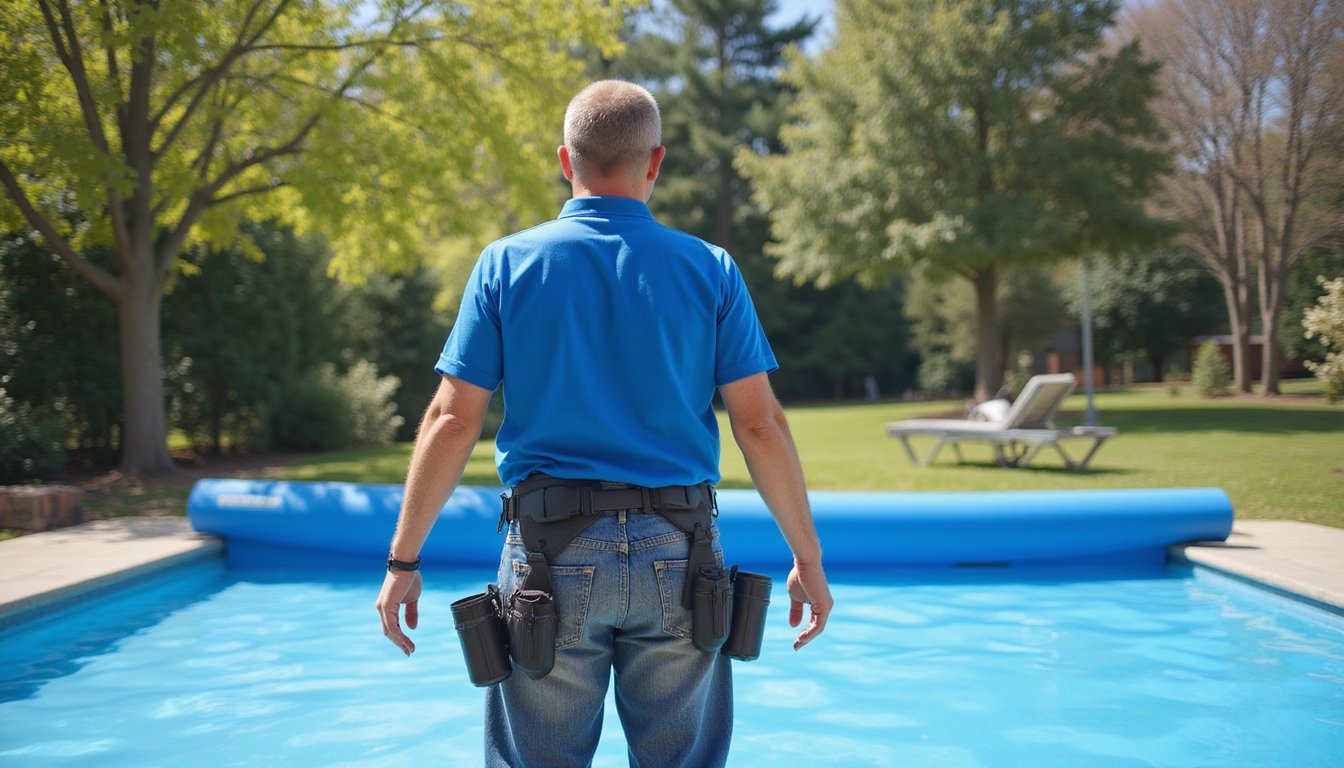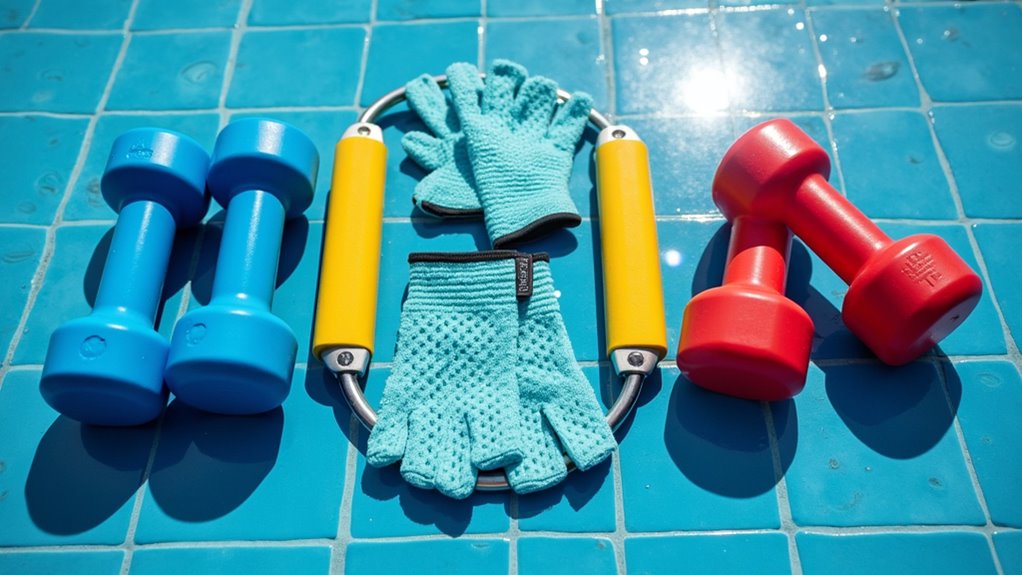You’ll need to initiate pool season with spring opening tasks in early March, focusing on cover removal and structural inspections. During peak summer months (June-August), maintain daily chemical testing and 12-18 hour filtration cycles. Schedule weekly cleaning from May through September, with twice-daily chemical checks during heavy use periods. Plan monthly deep cleanings and quarterly equipment assessments year-round. This structured timeline only scratches the surface of exhaustive pool maintenance planning.
Essential Spring Pool Opening Tasks

A successful spring pool opening requires careful execution of several critical tasks to guarantee your pool’s safe and efficient operation for the upcoming season. Begin by safely executing cover removal techniques, inspecting the material for winter damage before storage. You’ll need to clear debris and assess the pool’s structure for any cracks or wear. Professional expertise is essential for properly completing these technical tasks. Using a leaf blower can help efficiently remove debris from the pool cover without causing damage. Monthly monitoring during winter can help prevent excessive debris accumulation and make spring opening easier.
Following the winterization process reversal, you’ll reconnect and test all equipment, including pumps, filters, and heaters. Restore water levels to proper heights, typically two-thirds of the skimmer, while monitoring for potential leaks. Once filled, test and balance all chemical levels, including pH and alkalinity. Don’t forget to shock the pool and run the circulation system for at least 24 hours. Ultimately, verify all safety equipment is properly installed and functioning before allowing any swimming activity.
Peak Summer Maintenance Schedule
During peak summer operation, you’ll need to test your pool’s chemical levels daily, focusing on free chlorine (1-3 ppm) and pH (7.4-7.6) to maintain proper sanitization in high temperatures. Your pool’s filtration system must operate 12-18 hours per day to achieve complete water turnover and prevent algae growth during intense heat conditions. Monitor your equipment’s performance closely by checking pressure gauge readings, maintaining proper water levels at mid-skimmer height, and ensuring pump baskets remain clear of debris that could impair circulation. Weekly calcium hardness testing should be performed to prevent liner damage and scaling issues. To maintain optimal water quality, weekly water testing is crucial when the pool isn’t being used daily to ensure chemical balance remains stable. Clean the skimmer and pump basket at least 2-3 times per week to prevent circulation problems and maintain proper water flow.
Daily Chemical Testing Needs
Proper chemical testing stands out as the foundation of peak summer pool maintenance, with specific timing and frequency requirements that can’t be overlooked. You’ll need to conduct tests 2-3 times weekly during temperatures above 70°F, increasing to twice daily during periods of high swimmer contamination impact. A reliable four-way test kit is essential for accurate results. Weather conditions can significantly affect your pool’s chemical balance and may require additional testing. Some pool websites may restrict access through security measures to protect their testing guidelines and data.
For ideal accuracy, perform your testing between 9-11 AM when water chemistry has stabilized overnight. It’s essential to wait several hours after heavy usage periods, as swimmer-introduced contaminants can skew your readings. During high usage testing recommendations, you’ll want to monitor free chlorine levels daily, especially for pools used by children or pets. Commercial pools require daily testing of free chlorine, combined chlorine, pH, and temperature, while total alkalinity needs weekly attention unless pH fluctuates considerably.
Equipment Performance During Heat
Peak summer temperatures demand rigorous equipment management to prevent system failures and maintain ideal pool performance. You’ll need to optimize your filtration system’s energy efficiency by running the pump 8-12 hours daily, increasing duration when water becomes cloudy. For effective thermal load management, inspect your equipment regularly and maintain proper water levels at mid-skimmer height. Heat-related wear can accumulate gradually on pool equipment components even when not immediately noticeable. Proper chemical storage is essential to maintain equipment performance and safety during peak summer months.
Clean or backwash your filter every few weeks to prevent strain on the system. During heatwaves, your equipment works overtime, so you’ll need to monitor for signs of stress. Test water chemistry twice per week to ensure equipment isn’t struggling with imbalanced conditions. Implement a structured maintenance schedule: skim daily, brush walls weekly, and vacuum the pool bottom weekly. These practices help manage increased debris loads and prevent algae growth while protecting your equipment from heat-related damage. Don’t let water levels drop, as this can cause critical pump failures.
Weekly Chemical Testing Requirements

You’ll need to test your pool’s pH levels 2-3 times per week using an accurate testing kit to maintain proper water chemistry between 7.2-7.8. Your chlorine testing schedule should align with pH testing frequency, checking free chlorine levels 2-3 times weekly to maintain 1-3 ppm for ideal sanitization. Following a balanced chemical testing routine requires checking total alkalinity weekly, calcium hardness monthly, and increasing all test frequencies during periods of heavy usage or extreme weather conditions. Collecting samples from 12-18 inches deep ensures the most accurate test results for all chemical parameters.
Ph Testing Best Practices
Consistent pH testing forms the cornerstone of proper pool maintenance and water chemistry management. You’ll need to maintain pH levels between 7.2 and 7.8 while storing fresh reagents properly to prevent degradation from heat, cold, and moisture. When using phenol red indicator, collect water samples from 12-18 inches below the surface, away from jets and skimmers, to guarantee accurate readings. Liquid reagent kits deliver the highest accuracy for home pool testing. Testing your pool’s chemistry helps ensure compliance with Georgia health regulations and maintains a safe swimming environment.
- Test pH levels every couple of days using strips, digital testers, or liquid kits
- Add exactly five drops of phenol red reagent per test, holding the bottle upright
- Read results within one minute for liquid tests, or wait 15 seconds for test strips
Remember to start each swim season with new reagents and never mix testing components from different manufacturers, as this can lead to inaccurate readings and potentially unsafe water conditions.
Chlorine Level Maintenance Schedule
Regular chlorine level maintenance calls for precise weekly testing and monitoring to guarantee safe, properly sanitized pool water. You’ll need to maintain free chlorine levels between 1-3 ppm, with adjustments up to 4 ppm for above-ground pools. During peak swimming season, test your water chemistry 1-2 times per week and perform daily chemical checks of free chlorine levels.
Your chlorine shock treatment frequency should occur every 1-2 weeks, preferably during early morning or evening hours when sunlight won’t reduce its effectiveness. Follow chlorine level adjustment guidelines carefully, increasing testing during periods of heavy use or rainfall. Remember to keep your pump running while adding chemicals for proper distribution. For ideal results, coordinate your shock treatments with your regular weekly chemical testing schedule and supplement with monthly professional water testing.
Balanced Chemical Testing Routine
Building upon proper chlorine maintenance, a balanced chemical testing routine forms the foundation of pool water management. You’ll need to establish customized testing protocols based on temperature ranges and usage patterns while meeting regulatory documentation requirements.
- Test pH and chlorine levels 2-3 times weekly when temperatures exceed 70°F to maintain ideal chemical balance
- Reduce testing frequency to every two weeks during cooler periods (60-70°F), but maintain daily checks if children frequently use the pool
- Monitor calcium hardness and total dissolved solids monthly, with additional testing after significant weather events
Your testing schedule should adapt to seasonal changes and pool traffic. During peak summer months, increase testing to twice weekly minimum, and maintain detailed records of all chemical parameters to guarantee compliance with safety standards.
Seasonal Equipment Care Guidelines
Maintaining your pool equipment throughout changing seasons requires a systematic approach to protect critical components and safeguard ideal performance. Weekly monitoring of your pump and filter system helps detect issues early, while checking your robotic cleaner functionality verifies automated maintenance stays on track. For saltwater pools, you’ll need regular salt cell monitoring to prevent mineral buildup and maintain proper chlorination.
Your pump requires 8-12 hours of daily operation to maintain proper circulation, with weekly inspections to identify potential problems. You’ll want to clean the pump basket monthly and check filter pressure weekly, backwashing when it rises 10 psi above baseline. During spring opening and fall closing, confirm all equipment undergoes thorough assessment, including winterization procedures to prevent freeze damage during off-season periods.
Monthly Deep Cleaning Procedures
Thorough monthly deep cleaning procedures serve as the foundation for maintaining pristine pool conditions throughout the swimming season. You’ll need to drain and clean skimmer baskets, perform tank descaling procedures, and conduct exhaustive equipment inspections to prevent potential issues. Your monthly maintenance routine should align with manufacturer specifications while addressing both visible and concealed problem areas.
- Brush all surfaces thoroughly before vacuuming to dislodge stubborn buildup and prevent algae formation
- Backwash filters and clean cartridges to maintain ideal water flow and filtration efficiency
- Test and balance water chemistry levels, paying special attention to calcium hardness and pH
Remember to document your maintenance activities and chemical readings to track patterns and adjust your cleaning schedule accordingly. This systematic approach guarantees your pool remains safe and inviting while extending equipment lifespan.
Critical Safety Inspection Dates
To guarantee compliance with local regulations and maintain ideal safety standards, pool owners must adhere to specific inspection timelines throughout the year.
Your pre-season safety inspection must be completed by March 31 for year-round pools or before opening for seasonal facilities. You’ll need to schedule critical inspections beginning April 1st, but verify you’ve paid your annual operational permit fee. During this process, you’ll check fence integrity, gate self-latching mechanisms, and pool alarm functionality.
Throughout construction phases, you’re required to complete pre-gunite, pre-deck, and pre-plaster inspections at specific milestones. These checkpoints confirm proper installation of reinforcement, electrical bonding, and equipment. Before your post-season winterization process, conduct thorough equipment evaluations, including pumps, heaters, and safety systems, while documenting any structural concerns requiring attention before next season.
Water Chemistry Management Timeline
Since effective water chemistry management directly impacts pool safety and longevity, you’ll need to follow a structured timeline for chemical supplementations and testing procedures throughout the season. You’ll start with daily pH and chlorine monitoring, adjusting levels during non-swim periods to guarantee proper chemical dispersion.
Regular testing and proper chemical timing are essential safeguards for maintaining both pool water quality and swimmer protection.
- Perform shock application timing at 24-hour intervals after initial water balancing, maintaining chlorine levels below 3 ppm before implementing algae control measures
- Test water chemistry daily during peak swimming season, with increased frequency during periods of high temperatures or heavy rainfall
- Schedule weekly maintenance for total alkalinity, calcium hardness, and cyanuric acid testing, coordinating shock treatments to prevent chemical interference
Remember to allow proper waiting periods between chemical additions: 15-20 minutes for basic adjustments and one hour for complete distribution of shock treatments.
Filtration System Maintenance Cycles
Building on proper water chemistry practices, effective filtration system maintenance follows specific cycles throughout the pool season. You’ll need to start with spring preparation, inspecting O-rings, pump connections, and replacing pressure gauges every 3-5 years. During peak summer months, monitor your filter media maintenance closely, adjusting cleaning schedules based on pressure readings 8-10 psi above normal.
Your pump calibration frequency depends on filter type and usage patterns. Cartridge filters require cleaning every 2-4 weeks, while sand filters need backwashing based on pressure monitoring. Environmental factors like storms and heavy usage periods will necessitate supplementary maintenance. As fall approaches, focus on debris prevention and prepare for winter storage by thoroughly cleaning and drying all components to prevent freeze damage.
Year-Round Pool Cover Management
While proper pool maintenance requires year-round attention, effective pool cover management stands as a critical component for protecting your investment. You’ll need to implement specific maintenance protocols across seasons, including UV protection application during spring prep and snow removal strategies in winter months.
- Weekly tasks include debris removal, water level monitoring, and chemical dissipation checks
- Seasonal changes require thorough cleaning with mild detergents and complete system inspections
- Mechanical components need quarterly maintenance, including track cleaning and lubrication
Your cover maintenance schedule should align with seasonal demands. During summer, focus on weekly rinsing to remove chlorine buildup. In winter, you’ll need to prevent ice formation and remove snow immediately. Spring and fall call for deep cleaning and system testing to guarantee smooth operation year-round. Remember to use only approved cleaning solutions to maintain warranty coverage.
Frequently Asked Questions
When Should I Replace My Pool’s Vinyl Liner to Prevent Leaks?
You’ll want to schedule your liner installation in spring or fall, ideally before your liner shows critical wear. Watch for key liner replacement indicators like cracks, wrinkles, or water loss exceeding one inch per week. Don’t wait until you have leaks – plan your replacement at the 5-9 year mark of your current liner’s life. If you notice significant fading or brittleness near the waterline, start getting quotes immediately.
How Do Weather Conditions Affect My Pool Maintenance Schedule?
You’ll need to adjust your pool maintenance schedule based on seasonal temperature shifts and precipitation patterns. During hot weather, test chemicals daily as chlorine depletes faster and algae growth accelerates. After rainfall, you’ll need to rebalance chemicals and clear debris immediately. In winter, you can reduce testing to bi-weekly due to slower chemical reactions. UV exposure demands more frequent chlorine treatments, especially during peak sunlight hours.
What Are Signs My Pool Pump Needs Immediate Professional Servicing?
Watch for unusual noises like grinding, buzzing, or humming from your pump, as these indicate bearing failures or motor problems. You’ll notice decreased water flow or weak suction when your pump’s efficiency drops markedly. If you’re experiencing frequent circuit breaker trips, visible leaks, or the pump’s overheating during normal operation, don’t wait; call a professional immediately. These warning signs suggest serious internal issues that require expert attention.
Can I Safely Store Unused Pool Chemicals During the Off-Season?
Yes, you can safely store unused pool chemicals during off-season by following proper chemical storage guidelines. Keep them in their original containers in a temperature controlled environment below 95°F (35°C). Don’t stack containers, and store them off the floor in hard plastic bins with tight-fitting lids. You’ll need to separate different chemicals to prevent reactions, and guarantee your storage area remains dry, well-ventilated, and locked away from children and pets.
How Long Should I Wait After Shocking Before Allowing Swimmers?
You’ll need to wait at least 24 hours after using chlorine-based shock before allowing swimmers back in your pool. If you’re using a chlorine-free oxidizing shock, you can reduce the waiting period to about 15 minutes. Before letting anyone swim, always test your water to guarantee chlorine levels are between 1-3 ppm and pH is 7.2-7.8. Run your pump during this waiting period to ascertain proper chemical distribution.
